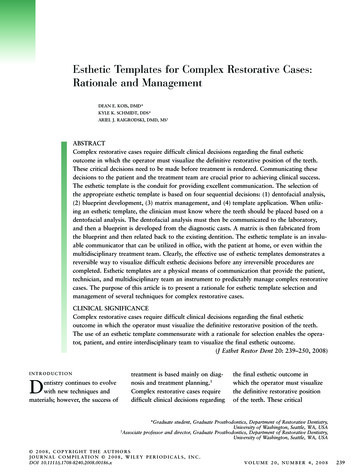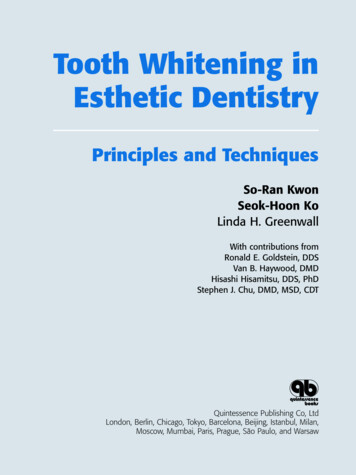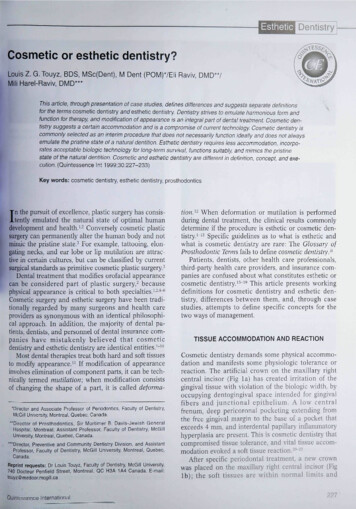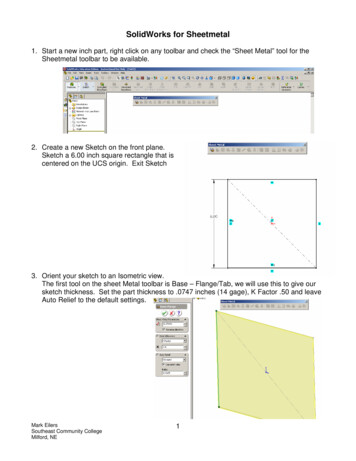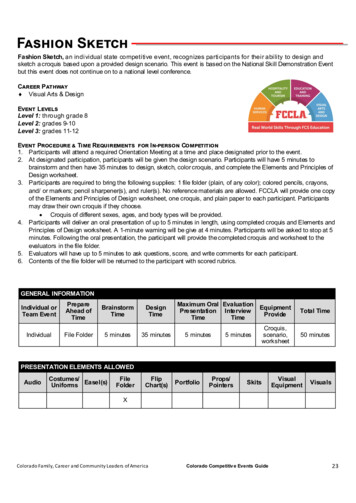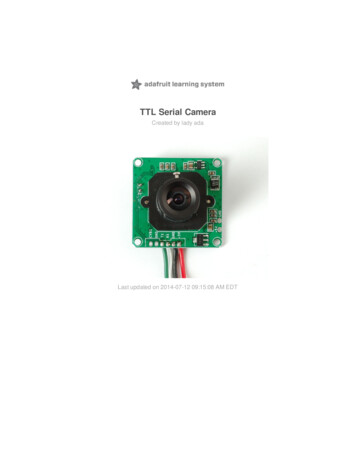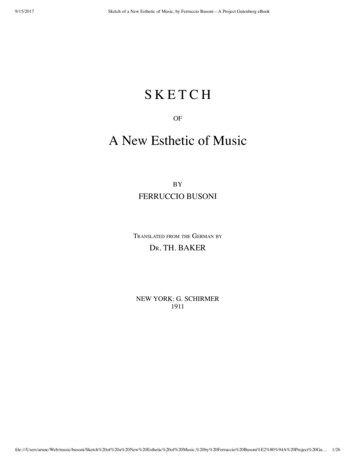
Transcription
9/15/2017Sketch of a New Esthetic of Music, by Ferruccio Busoni—A Project Gutenberg eBookSKETCHOFA New Esthetic of MusicBYFERRUCCIO BUSONITRANSLATED FROM THE GERMAN BYDR. TH. BAKERNEW YORK: G. y%20Ferruccio%20Busoni%E2%80%94A%20Project%20Gu 1/26
9/15/2017Sketch of a New Esthetic of Music, by Ferruccio Busoni—A Project Gutenberg eBookCopyright, 1907By FERRUCCIO BUSONICopyright, 1911By G. by%20Ferruccio%20Busoni%E2%80%94A%20Project%20Gu 2/26
9/15/2017Sketch of a New Esthetic of Music, by Ferruccio Busoni—A Project Gutenberg eBookSKETCH OF A NEW ESTHETIC OF MUSIC“What seek you? Say! And what do you expect?”—“I know not what; the Unknown I would have!What's known to me, is endless; I would goBeyond the end: The last word still is wanting.”[“Der mächtige Zauberer.”]joined together as regards literary form, the following notes are, inL OOSELYreality, the outcome of convictions long held and slowly matured.In them a problem of the first magnitude is formulated with apparent simplicity,without giving the key to its final solution; for the problem cannot be solved forgenerations—if at all.But it involves an innumerable series of lesser problems, which I present to theconsideration of those whom they may concern. For it is a long time since any one hasdevoted himself to earnest musical research.It is true, that admirable works of genius arise in every period, and I have alwaystaken my stand in the front rank of those who joyfully acclaimed the passing standardbearers; and still it seems to me that of all these beautiful paths leading so far afield—none lead upward.The spirit of an art-work, the measure of emotion, of humanity, that is in it—theseremain unchanged in value through changing years; the form which these threeassumed, the manner of their expression, and the flavor of the epoch which gave thembirth, are transient, and age rapidly.Spirit and emotion retain their essence, in the art-work as in man himself; weadmire technical achievements, yet they are outstripped, or cloy the taste and arediscarded.Its ephemeral qualities give a work the stamp of “modernity;” its unchangeableessence hinders it from becoming “obsolete.” Among both “modern” and “old” workswe find good and bad, genuine and spurious. There is nothing properly modern—onlythings which have come into being earlier or later; longer in bloom, or soonerwithered. The Modern and the Old have always been.CHARACTERIZATION OF THE ARTSArt-forms are the more lasting, the more closely they adhere to the nature of theirindividual species of art, the purer they keep their essential means and ruccio%20Busoni%E2%80%94A%20Project%20Gu 3/26
9/15/2017Sketch of a New Esthetic of Music, by Ferruccio Busoni—A Project Gutenberg eBookSculpture relinquishes the expression of the human pupil, and effects of color;painting degenerates, when it forsakes the flat surface in depiction and takes oncomplexity in theatrical decoration or panoramic portrayal.Architecture has its fundamental form, growth from below upward, prescribed bystatic necessity; window and roof necessarily provide the intermediate and finishingconfiguration; these are eternal and inviolable requirements of the art.Poetry commands the abstract thought, which it clothes in words. Moreindependent than the others, it reaches the furthest bounds.But all arts, resources and forms ever aim at the one end, namely, the imitation ofnature and the interpretation of human feelings.***Architecture, sculpture, poetry and painting are old and mature arts; theirconceptions are established and their objects assured; they have found the way throughuncounted centuries, and, like the planets, describe their regular orbits.[A]Music, compared with them, is a child that has learned to walk, but must still beled. It is a virgin art, without experience in life and suffering.It is all unconscious as yet of what garb is becoming, of its own advantages, itsunawakened capacities. And again, it is a child-marvel that is already able to dispensemuch of beauty, that has already brought joy to many, and whose gifts are commonlyheld to have attained full maturity.***Music as an art, our so-called occidental music, is hardly four hundred years old;its state is one of development, perhaps the very first stage of a development beyondpresent conception, and we—we talk of “classics” and “hallowed traditions”! And wehave talked of them for a long time![B]We have formulated rules, stated principles, laid down laws;—we apply laws madefor maturity to a child that knows nothing of responsibility!***Young as it is, this child, we already recognize that it possesses one radiantattribute which signalizes it beyond all its elder sisters. And the lawgivers will not seethis marvelous attribute, lest their laws should be thrown to the winds. This child—itfloats on air! It touches not the earth with its feet. It knows no law of gravitation. It iswellnigh incorporeal. Its material is transparent. It is sonorous air. It is almost Natureherself. It 20Ferruccio%20Busoni%E2%80%94A%20Project%20Gu 4/26
9/15/2017Sketch of a New Esthetic of Music, by Ferruccio Busoni—A Project Gutenberg eBook***But freedom is something that mankind have never wholly comprehended, neverrealized to the full. They can neither recognize nor acknowledge it.They disavow the mission of this child; they hang weights upon it. This buoyantcreature must walk decently, like anybody else. It may scarcely be allowed to leap—when it were its joy to follow the line of the rainbow, and to break sunbeams with theclouds.***ABSOLUTE MUSICMusic was born free; and to win freedom is its destiny. It will become the mostcomplete of all reflexes of Nature by reason of its untrammeled immateriality. Eventhe poetic word ranks lower in point of incorporealness. It can gather together anddisperse, can be motionless repose or wildest tempestuosity; it has the extremestheights perceptible to man—what other art has these?—and its emotion seizes thehuman heart with that intensity which is independent of the “idea.”It realizes a temperament, without describing it, with the mobility of the soul, withthe swiftness of consecutive moments; and this, where painter or sculptor canrepresent only one side or one moment, and the poet tardily communicates atemperament and its manifestations by words.Therefore, representation and description are not the nature of music; herewith wedeclare the invalidity of program-music, and arrive at the question: What are the aimsof music?***Music! What the lawgivers mean by this, is perhaps remotest of allA BSOLUTEfrom the Absolute in music. “Absolute music” is a form-play without poeticprogram, in which the form is intended to have the leading part. But Form, in itself, isthe opposite pole of absolute music, on which was bestowed the divine prerogative ofbuoyancy, of freedom from the limitations of matter. In a picture, the illustration of asunset ends with the frame; the limitless natural phenomenon is enclosed inquadrilateral bounds; the cloud-form chosen for depiction remains unchanging forever. Music can grow brighter or darker, shift hither or yon, and finally fade away likethe sunset glow itself; and instinct leads the creative musician to employ the tones thatpress the same key within the human breast, and awaken the same response, as theprocesses in Nature.Per contra, “absolute music” is something very sober, which reminds one ofmusic-desks in orderly rows, of the relation of Tonic to Dominant, of Developmentsand rruccio%20Busoni%E2%80%94A%20Project%20Gu 5/26
9/15/2017Sketch of a New Esthetic of Music, by Ferruccio Busoni—A Project Gutenberg eBookTHE FETISH OF FORMMethinks I hear the second violin struggling, a fourth below, to emulate the moredexterous first, and contending in needless contest merely to arrive at the startingpoint. This sort of music ought rather to be called the “architectonic,” or “symmetric,”or “sectional,” and derives from the circumstance that certain composers poured theirspirit and their emotion into just this mould as lying nearest them or their time. Ourlawgivers have identified the spirit and emotion, the individuality of these composersand their time, with “symmetric” music, and finally, being powerless to recreate eitherthe spirit, or the emotion, or the time, have retained the Form as a symbol, and made itinto a fetish, a religion. The composers sought and found this form as the aptestvehicle for communicating their ideas; their souls took flight—and the lawgiversdiscover and cherish the garments Euphorion left behind on earth.A lucky find! 'Twas now or never;The flame is gone, it's true—however,No need to pity mankind now.Enough is left for many a poet's tiring,Or to breed envy high and low;And though I have no talents here for hiring,I'll hire the robe out, anyhow.Is it not singular, to demand of a composer originality in all things, and to forbid itas regards form? No wonder that, once he becomes original, he is accused of“formlessness.” Mozart! the seeker and the finder, the great man with the childlikeheart—it is he we marvel at, to whom we are devoted; but not his Tonic andDominant, his Developments and Codas.***Such lust of liberation filled Beethoven, the romantic revolutionary, that heascended one short step on the way leading music back to its loftier self:—a short stepin the great task, a wide step in his own path. He did not quite reach absolute music,but in certain moments he divined it, as in the introduction to the fugue of the Sonatafor Hammerclavier. Indeed, all composers have drawn nearest the true nature of musicin preparatory and intermediary passages (preludes and transitions), where they felt atliberty to disregard symmetrical proportions, and unconsciously drew free breath.Even a Schumann (of so much lower stature) is seized, in such passages, by somefeeling of the boundlessness of this pan-art (recall the transition to the last movementof the D-minor Symphony); and the same may be asserted of Brahms in theintroduction to the Finale of his First Symphony.But, the moment they cross the threshold of the Principal Subject, their attitudebecomes stiff and conventional, like that of a man entering some bureau of %20Gu 6/26
9/15/2017Sketch of a New Esthetic of Music, by Ferruccio Busoni—A Project Gutenberg eBookBACH, BEETHOVEN, WAGNERNext to Beethoven, Bach bears closest affinity to “infinite music.”[C] His OrganFantasias (but not the Fugues) have indubitably a strong dash of what might beoverwritten “Man and Nature.”[D] In him it appears most ingenuous because he hadno reverence for his predecessors (although he esteemed and made use of them), andbecause the still novel acquisition of equal temperament opened a vista of—for thetime being—endless new possibilities.Therefore, Bach and Beethoven[E] are to be conceived as a beginning, and not asunsurpassable finalities. In spirit and emotion they will probably remain unexcelled;and this, again, confirms the remark at the beginning of these lines: That spirit andemotion remain unchanged in value through changing years, and that he who mountsto their uttermost heights will always tower above the crowd.***What still remains to be surpassed, is their form of expression and their freedom.Wagner, a Germanic Titan, who touched our earthly horizon in orchestral tone-effect,who intensified the form of expression, but fashioned it into a system (music-drama,declamation, leading-motive), is on this account incapable of further intensification.His category begins and ends with himself; first, because he carried it to the highestperfection and finish; secondly, because his self-imposed task was of such a nature,that it could be achieved by one man alone.[F] The paths opened by Beethoven can befollowed to their end only through generations. They—like all things in creation—mayform only a circle; but a circle of such dimensions, that the portion visible to us seemslike a straight line. Wagner's circle we can view in its entirety—a circle within thegreat circle.***PROGRAM AND MOTIVEname of Wagner leads to program-music. This has been set up as a contrast toT HEso-called “absolute” music, and these concepts have become so petrified that evenpersons of intelligence hold one or the other dogma, without recognition for a thirdpossibility beyond and above the other two. In reality, program-music is precisely asone-sided and limited as that which is called absolute. In place of architectonic andsymmetric formulas, instead of the relation of Tonic to Dominant, it has bound itself inthe stays of a connecting poetic—sometimes even philosophic—program.***Every motive—so it seems to me—contains, like a seed, its life-germ within itself.From the different plant-seeds grow different families of plants, dissimilar in form,foliage, blossom, fruit, growth and 0Ferruccio%20Busoni%E2%80%94A%20Project%20Gu 7/26
9/15/2017Sketch of a New Esthetic of Music, by Ferruccio Busoni—A Project Gutenberg eBookEven each individual plant belonging to one and the same species assumes, in size,form and strength, a growth peculiar to itself. And so, in each motive, there lies theembryo of its fully developed form; each one must unfold itself differently, yet eachobediently follows the law of eternal harmony. This form is imperishable, though eachbe unlike every other.***The motive in a composition with program bears within itself the same naturalnecessity; but it must, even in its earliest phase of development, renounce its ownproper mode of growth to mould—or, rather, twist—itself to fit the needs of theprogram. Thus turned aside, at the outset, from the path traced by nature, it finallyarrives at a wholly unexpected climax, whither it has been led, not by its ownorganization, but by the way laid down in the program, or the action, or thephilosophical idea.And how primitive must this art remain! True, there are unequivocal descriptiveeffects of tone-painting (from these the entire principle took its rise), but these meansof expression are few and trivial, covering but a very small section of musical art.Begin with the most self-evident of all, the debasement of Tone to Noise in imitatingthe sounds of Nature—the rolling of thunder, the roar of forests, the cries of animals;then those somewhat less evident, symbolic—imitations of visual impressions, like thelightning-flash, springing movement, the flight of birds; again, those intelligible onlythrough the mediation of the reflective brain, such as the trumpet-call as a warlikesymbol, the shawm to betoken ruralism, march-rhythm to signify measured strides, thechorale as vehicle for religious feeling. Add to the above the characterization ofnationalities—national instruments and airs—and we have a complete inventory of thearsenal of program-music. Movement and repose, minor and major, high and low, intheir customary significance, round out the list.—These are auxiliaries, of which gooduse can be made upon a broad canvas, but which, taken by themselves, are no more tobe called music than wax figures may pass for monuments.***And, after all, what can the presentation of a little happening upon this earth, thereport concerning an annoying neighbor—no matter whether in the next room or in anadjoining quarter of the globe—have in common with that music which pervades theuniverse?WHAT MUSIC EXPRESSESTo music, indeed, it is given to set in vibration our human moods: Dread(Leporello), oppression of soul, invigoration, lassitude (Beethoven's last Quartets),decision (Wotan), hesitation, despondency, encouragement, harshness, tenderness,excitement, tranquillization, the feeling of surprise or expectancy, and still others;likewise the inner echo of external occurrences which is bound up in these moods ofthe soul. But not the moving cause itself of these spiritual affections;—not the joy overan avoided danger, not the danger itself, or the kind of danger which caused the dread;an emotional state, yes, but not the psychic species of this emotion, such as envy, cio%20Busoni%E2%80%94A%20Project%20Gu 8/26
9/15/2017Sketch of a New Esthetic of Music, by Ferruccio Busoni—A Project Gutenberg eBookjealousy; and it is equally futile to attempt the expression, through music, of moralcharacteristics (vanity, cleverness), or abstract ideas like truth and justice. Is it possibleto imagine how a poor, but contented man could be represented by music? Thecontentment, the soul-state, can be interpreted by music; but where does the povertyappear, or the important ethic problem stated in the words “poor, but contented”? Thisis due to the fact that “poor” connotes a phase of terrestrial and social conditions not tobe found in the eternal harmony. And Music is a part of the vibrating universe.***I may be allowed to subjoin a few subsidiary reflections:—The greater part ofmodern theatre music suffers from the mistake of seeking to repeat the scenes passingon the stage, instead of fulfilling its own proper mission of interpreting the soul-statesof the persons represented. When the scene presents the illusion of a thunderstorm,this is exhaustively apprehended by the eye. Nevertheless, nearly all composers striveto depict the storm in tones—which is not only a needless and feebler repetition, butlikewise a failure to perform their true function. The person on the stage is eitherpsychically influenced by the thunderstorm, or his mood, being absorbed in a train ofthought of stronger influence, remains unaffected. The storm is visible and audiblewithout aid from music; it is the invisible and inaudible, the spiritual processes of thepersonages portrayed, which music should render intelligible.***Again, there are “obvious” psychic conditions on the stage, whereof music needtake no account. Suppose a theatrical situation in which a convivial company ispassing at night and disappears from view, while in the foreground a silent,envenomed duel is in progress. Here the music, by means of continuing song, shouldkeep in mind the jovial company now lost to sight; the acts and feelings of the pair inthe foreground may be understood without further commentary, and the music—dramatically speaking—ought not to participate in their action and break the tragicsilence.Measurably justified, in my opinion, is the plan of the old opera, whichconcentrated and musically rounded out the passions aroused by a moving dramaticscene in a piece of set form (the aria). Word and stage-play conveyed the dramaticprogress of the action, followed more or less meagrely by musical recitative; arrived atthe point of rest, music resumed the reins. This is less extrinsic than some would nowhave us believe. On the other hand, it was the ossified form of the “aria” itself whichled to inveracity of expression and decadence.***NOTATION VERSUS EMOTIONaudible presentation, the “performance,” of music, its emotionalT HEinterpretation, derives from those free heights whence descended the Art erruccio%20Busoni%E2%80%94A%20Project%20Gu 9/26
9/15/2017Sketch of a New Esthetic of Music, by Ferruccio Busoni—A Project Gutenberg eBookWhere the art is threatened by earthliness, it is the part of interpretation to raise it andreëndow it with its primordial essence.Notation, the writing out of compositions, is primarily an ingenious expedient forcatching an inspiration, with the purpose of exploiting it later. But notation is toimprovisation as the portrait to the living model. It is for the interpreter to resolve therigidity of the signs into the primitive emotion.But the lawgivers require the interpreter to reproduce the rigidity of the signs; theyconsider his reproduction the nearer to perfection, the more closely it clings to thesigns.—What the composer's inspiration necessarily loses[H] through notation, hisinterpreter should restore by his own.To the lawgivers, the signs themselves are the most important matter, and arecontinually growing in their estimation; the new art of music is derived from the oldsigns—and these now stand for musical art itself.If the lawgivers had their way, any given composition would always be reproducedin precisely the same tempo, whensoever, by whomsoever, and under whatsoeverconditions it might be performed.But, it is not possible; the buoyant, expansive nature of the divine child rebels—itdemands the opposite. Each day begins differently from the preceding, yet always withthe flush of dawn.—Great artists play their own works differently at each repetition,remodel them on the spur of the moment, accelerate and retard, in a way which theycould not indicate by signs—and always according to the given conditions of that“eternal harmony.”And then the lawgiver chafes, and refers the creator to his own handwriting. Asmatters stand to-day, the lawgiver has the best of the argument.***NOTATION AND TRANSCRIPTION“Notation” (“writing down”) brings up the subject of Transcription, nowadays aterm much misunderstood, almost discreditable. The frequent antagonism which Ihave excited with “transcriptions,” and the opposition to which an ofttimes irrationalcriticism has provoked me, caused me to seek a clear understanding of this point. Myfinal conclusion concerning it is this: Every notation is, in itself, the transcription of anabstract idea. The instant the pen seizes it, the idea loses its original form. The veryintention to write down the idea, compels a choice of measure and key. The form, andthe musical agency, which the composer must decide upon, still more closely definethe way and the limits.It is much the same as with man himself. Born naked, and as yet without definiteaspirations, he decides, or at a given moment is made to decide, upon a career. Fromthe moment of decision, although much that is original and imperishable in the idea orthe man may live on, either is depressed to the type of a class. The musical ideabecomes a sonata or a concerto; the man, a soldier or a priest. That is an %20Ferruccio%20Busoni%E2%80%94A%20Project%20G 10/26
9/15/2017Sketch of a New Esthetic of Music, by Ferruccio Busoni—A Project Gutenberg eBookof the original. From this first transcription to a second the step is comparatively shortand unimportant. And yet it is only the second, in general, of which any notice istaken; overlooking the fact, that a transcription does not destroy the archetype, whichis, therefore, not lost through transcription.Again, the performance of a work is also a transcription, and still, whateverliberties it may take, it can never annihilate the original.For the musical art-work exists, before its tones resound and after they die away,complete and intact. It exists both within and outside of time, and through its naturewe can obtain a definite conception of the otherwise intangible notion of the Idealityof Time.For the rest, most of Beethoven's piano compositions sound like transcriptions oforchestral works; most of Schumann's orchestral compositions, like arrangementsfrom pieces for the piano—and they are so, in a way.***Strangely enough, the Variation-Form is highly esteemed by the Worshippers ofthe Letter. That is singular; for the variation-form—when built up on a borrowedtheme—produces a whole series of “arrangements” which, besides, are leastrespectful when most ingenious.So the arrangement is not good, because it varies the original; and the variation isgood, although it “arranges” the original.***WHAT IS MUSICAL?term “musikalisch” (musical) is used by the Germans in a sense foreign to thatT HEin which any other language employs it.[I] It is a conception belonging to theGermans, and not to culture in general; the expression is incorrect and untranslatable.“Musical” is derived from music, like “poetical” from poetry, or “physical” fromphysic(s). When I say, “Schubert was one of the most musical among men,” it is thesame as if I should say, “Helmholtz was one of the most physical among men.” That ismusical, which sounds in rhythms and intervals. A cupboard can be “musical,” if“music-works” be enclosed in it.[J] In a comparative sense, “musical” may have thefurther signification of “euphonious.”—“My verses are too musical to bear setting tomusic,” a noted poet once remarked to me.“Spirits moving musicallyTo a lute's well-tuned law,”writes Edgar Allan Poe. Lastly, one may speak quite correctly of “musical laughter,”because it sounds like rruccio%20Busoni%E2%80%94A%20Project%20G 11/26
9/15/2017Sketch of a New Esthetic of Music, by Ferruccio Busoni—A Project Gutenberg eBookTaking the signification in which the term is applied and almost exclusivelyemployed in German, a musical person is one who manifests an inclination for musicby a nice discrimination and sensitiveness with regard to the technical aspects of theart. By “technics” I mean rhythm, harmony, intonation, part-leading, and the treatmentof themes. The more subtleties he is capable of hearing or reproducing in these, themore “musical” he is held to be.In view of the great importance attached to these elements of the art, this“musical” temperament has naturally become of the highest consequence. And so anartist who plays with perfect technical finish should be deemed the most musicalplayer. But as we mean by “technics” only the mechanical mastery of the instrument,the terms “technical” and “musical” have been turned into opposites.The matter has been carried so far as to call a composition itself “musical,”[K] oreven to assert of a great composer like Berlioz that he was not sufficiently musical.[L]“Unmusical” conveys the strongest reproach; branded thus, its object becomes anoutlaw.[M]In a country like Italy, where all participate in the delights of music, thisdifferentiation becomes superfluous, and the term corresponding is not found in thelanguage. In France, where a living sense of music does not permeate the people, thereare musicians and non-musicians; of the rest, some “are very fond of music,” andothers “do not care for it.” Only in Germany is it made a point of honor to be“musical,” that is to say, not merely to love music, but more especially to understand itas regards its technical means of expression, and to obey their rules.A thousand hands support the buoyant child and solicitously attend its footsteps,that it may not soar aloft where there might be risk of a serious fall. But it is still soyoung, and is eternal; the day of its freedom will come.—When it shall cease to be“musical.”***creator should take over no traditional law in blind belief, which would makeT HEhim view his own creative endeavor, from the outset, as an exception contrastingwith that law. For his individual case he should seek out and formulate a fittingindividual law, which, after the first complete realization, he should annul, that hehimself may not be drawn into repetitions when his next work shall be in the making.The function of the creative artist consists in making laws, not in following lawsready made. He who follows such laws, ceases to be a creator.Creative power may be the more readily recognized, the more it shakes itself loosefrom tradition. But an intentional avoidance of the rules cannot masquerade as creativepower, and still less engender it.The true creator strives, in reality, after perfection only. And through bringing thisinto harmony with his own individuality, a new law arises without G 12/26
9/15/2017Sketch of a New Esthetic of Music, by Ferruccio Busoni—A Project Gutenberg eBookSo narrow has our tonal range become, so stereotyped its form of expression, thatnowadays there is not one familiar motive that cannot be fitted with some otherfamiliar motive so that the two may be played simultaneously. Not to lose my way intrifling,[N] I shall refrain from giving examples.***That which, within our present-day music, most nearly approaches the essentialnature of the art, is the Rest and the Hold (Pause). Consummate players, improvisers,know how to employ these instruments of expression in loftier and ampler measure.The tense silence between two movements—in itself music, in this environment—leaves wider scope for divination than the more determinate, but therefore less elastic,sound.***MUSIC, AND SIGNS FOR MUSICWhat we now call our Tonal System is nothing more than a set of “signs”; aningenious device to grasp somewhat of that eternal harmony; a meagre pocket-editionof that encyclopedic work; artificial light instead of the sun.—Have you ever noticedhow people gaze open-mouthed at the brilliant illumination of a hall? They never doso at the millionfold brighter sunshine of noonday.—And so, in music, the signs have assumed greater consequence than that whichthey ought to stand for, and can only suggest.How important, indeed, are “Third,” “Fifth,” and “Octave”! How strictly we divide“consonances” from “dissonances”—in a sphere where no dissonances can possiblyex
9/15/2017 Sketch of a New Esthetic of Music, by Ferruccio Busoni—A Project Gutenberg eBook 20a%20New%20Esthetic .


